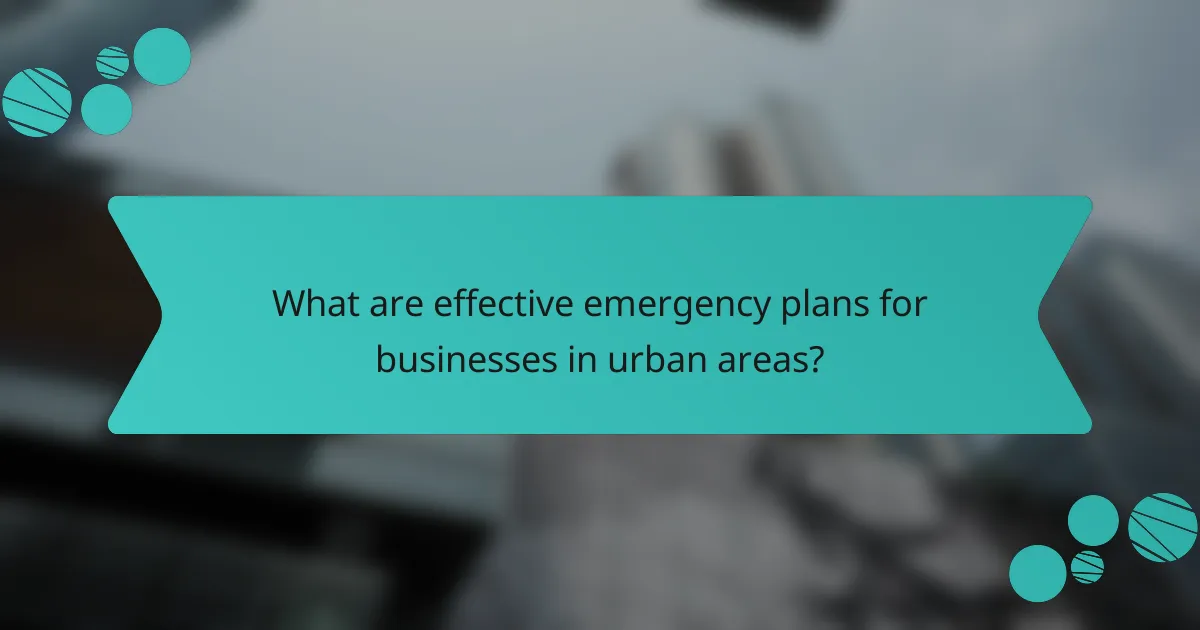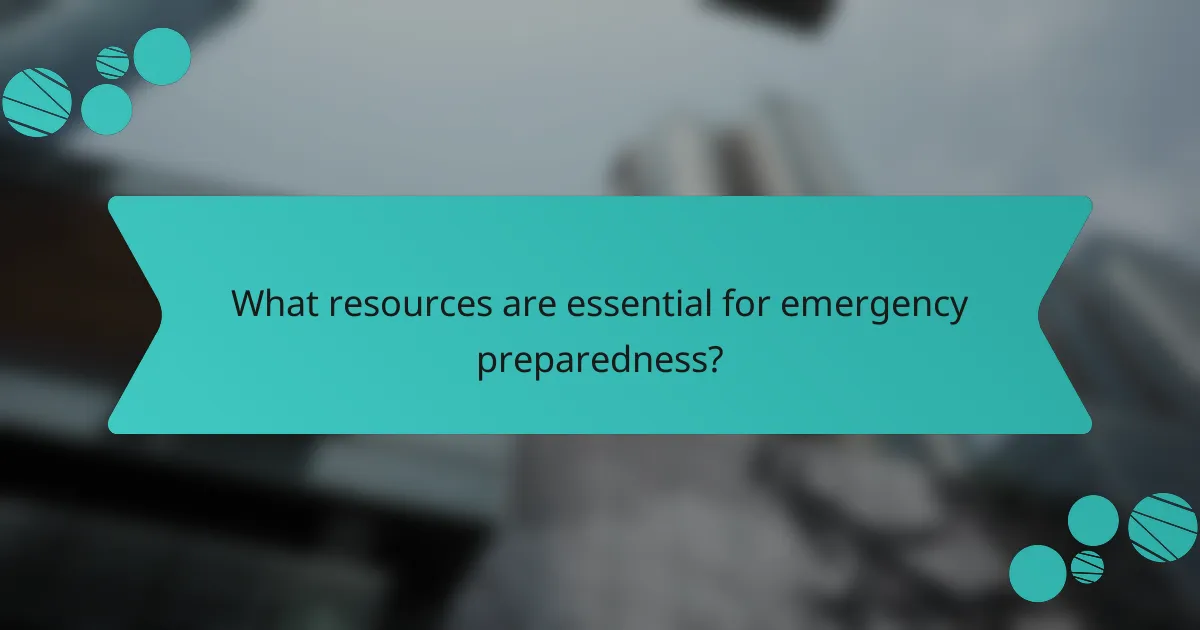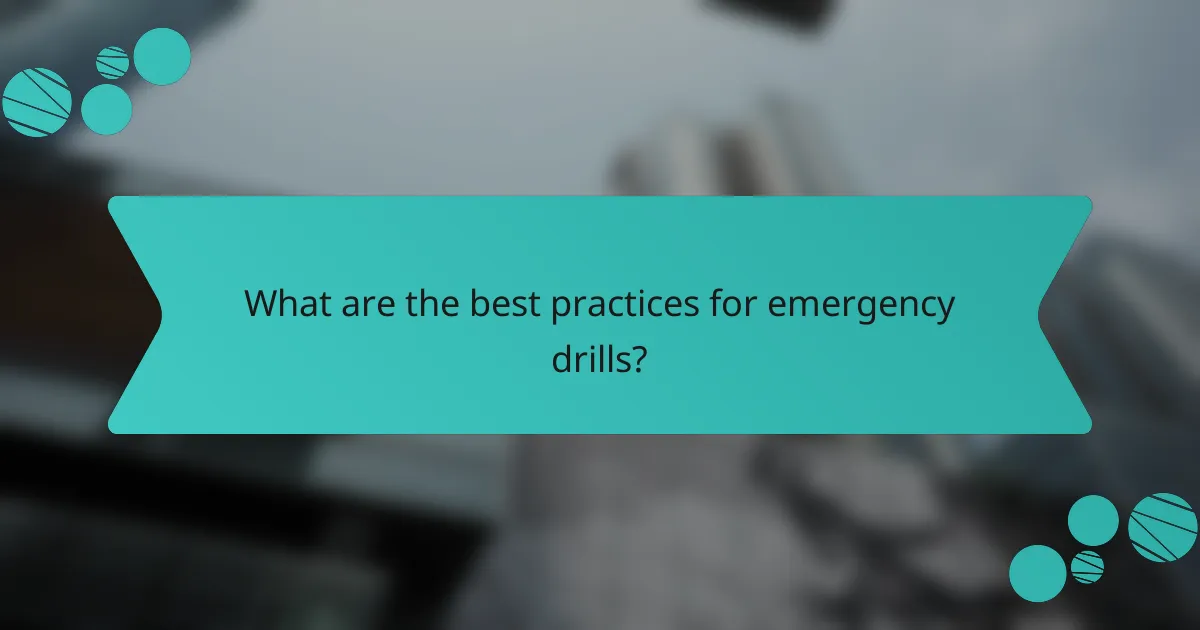Establishing effective emergency plans is crucial for businesses, particularly in urban settings where risks can be heightened. These plans should include comprehensive risk assessments, resource identification, and robust communication strategies to ensure preparedness and swift response during crises. By systematically evaluating potential hazards and necessary resources, organizations can enhance their resilience and safeguard their operations.

What are effective emergency plans for businesses in urban areas?
Effective emergency plans for businesses in urban areas focus on preparedness, rapid response, and recovery strategies tailored to the specific risks of the environment. These plans should encompass risk assessments, resource identification, communication strategies, staff training, and collaboration with local emergency services.
Comprehensive risk assessments
Comprehensive risk assessments identify potential hazards that could impact a business, such as natural disasters, civil unrest, or technological failures. Businesses should evaluate the likelihood and potential impact of these risks, considering factors like location, building structure, and employee safety.
Regularly updating risk assessments is crucial, as urban environments can change rapidly due to new developments or shifts in demographics. Engaging employees in the assessment process can provide valuable insights and foster a culture of safety.
Resource identification strategies
Identifying resources involves cataloging essential supplies, equipment, and personnel needed during an emergency. Businesses should create a list of critical resources, such as first aid kits, emergency contact lists, and backup power sources.
Consider establishing partnerships with local suppliers to ensure quick access to necessary materials during a crisis. Regularly reviewing and updating this inventory helps maintain readiness and ensures that resources are available when needed.
Communication plans for crisis management
Effective communication plans are vital for managing crises and keeping employees informed. Establish clear channels for disseminating information, such as text alerts, emails, or dedicated apps, ensuring that all staff members know how to receive updates.
Regularly test these communication methods to ensure they function correctly during emergencies. Providing training on how to use these systems can enhance overall effectiveness and reduce confusion during a crisis.
Training and drills for staff
Training and drills prepare employees to respond effectively in emergencies. Conduct regular training sessions that cover emergency protocols, evacuation routes, and first aid procedures to ensure everyone knows their roles during a crisis.
Simulated drills can help reinforce these procedures, allowing staff to practice their responses in a controlled environment. Aim for at least one drill per quarter to maintain readiness and address any gaps in knowledge or execution.
Collaboration with local emergency services
Collaborating with local emergency services enhances a business’s emergency preparedness. Establish relationships with local police, fire departments, and medical services to ensure a coordinated response during a crisis.
Invite emergency service representatives to conduct training sessions or participate in drills. This collaboration can improve communication and response times, ultimately enhancing safety for employees and the surrounding community.

How to conduct a risk assessment for emergencies?
Conducting a risk assessment for emergencies involves identifying potential hazards, evaluating the vulnerability of assets, and determining the likelihood and impact of risks. This systematic approach helps organizations prepare for and mitigate the effects of emergencies effectively.
Identify potential hazards
Start by listing all possible hazards that could affect your organization, such as natural disasters, technological failures, or human-related incidents. Engage with employees and stakeholders to gather insights on risks specific to your location and operations.
Common hazards include floods, earthquakes, fires, and cyber threats. Consider local environmental factors and historical data to prioritize which hazards are most relevant to your context.
Evaluate vulnerability of assets
Assess the vulnerability of your assets, including people, facilities, and technology. Identify which assets are critical to your operations and how they might be affected by the identified hazards.
For example, if your facility is in a flood-prone area, evaluate the structural integrity and emergency preparedness of your buildings. Use a simple rating system to categorize assets based on their vulnerability, such as low, medium, or high.
Determine likelihood and impact of risks
For each identified hazard, estimate the likelihood of occurrence and the potential impact on your organization. This can be done using qualitative measures like high, medium, or low, or through more quantitative methods if data is available.
Consider both immediate and long-term impacts, including financial losses, operational disruptions, and reputational damage. A risk matrix can help visualize and prioritize risks based on their likelihood and impact, guiding your emergency planning efforts.

What resources are essential for emergency preparedness?
Essential resources for emergency preparedness include supplies, equipment, and plans that ensure safety and effective response during crises. Identifying these resources helps individuals and organizations mitigate risks and respond efficiently when emergencies arise.
Emergency supplies and equipment
Emergency supplies and equipment are vital for immediate response during a crisis. Key items include non-perishable food, water, flashlights, batteries, and a multi-tool. It’s advisable to have enough supplies to last at least three days for each person in your household.
Consider storing these items in a designated emergency kit that is easily accessible. Regularly check and update the kit to replace expired items and ensure all equipment is functional.
Contact lists for emergency services
Having a comprehensive contact list for emergency services is crucial for quick access during a crisis. This list should include local police, fire departments, hospitals, and poison control centers. Ensure that these numbers are easily accessible, such as in your phone and posted in a visible location at home.
Additionally, include contacts for family members, neighbors, and friends who can assist or provide support during emergencies. Regularly update this list to reflect any changes in contact information.
Backup power sources
Backup power sources are essential to maintain operations during power outages. Options include portable generators, solar chargers, and battery banks. When selecting a backup power source, consider the power needs of critical devices and the duration for which you may need power.
Ensure that your backup power sources are properly maintained and tested regularly. Familiarize yourself with the operation of these devices to avoid confusion during an emergency.
First aid kits and medical supplies
A well-stocked first aid kit is a critical resource for managing injuries and health issues during emergencies. Basic supplies should include adhesive bandages, antiseptic wipes, gauze, and pain relievers. Consider the specific needs of your household, such as any chronic conditions or allergies, when assembling your kit.
Regularly check the contents of your first aid kit to replace expired items and add any necessary medications. It’s also beneficial to take a first aid training course to enhance your preparedness for medical emergencies.

How to develop effective communication strategies?
Effective communication strategies are essential for ensuring that information flows smoothly during emergencies. These strategies should prioritize clarity, accessibility, and timely dissemination of information to all stakeholders involved.
Establish a communication hierarchy
Creating a communication hierarchy involves defining roles and responsibilities within your organization. Identify key personnel who will relay information and make decisions during an emergency, ensuring that everyone knows who to contact and who is in charge.
For example, designate a primary spokesperson to handle media inquiries and internal communications. This helps prevent mixed messages and confusion among staff and external parties.
Utilize multiple communication channels
Using various communication channels increases the likelihood that messages reach everyone effectively. Consider employing email, text messages, social media, and even physical notices to ensure broad coverage.
For instance, during an emergency, a text alert can quickly inform staff of immediate actions, while email can provide detailed instructions. This multi-channel approach caters to different preferences and situations.
Regular updates and training for staff
Regular updates and training sessions are crucial for keeping staff informed and prepared. Schedule periodic drills and refreshers on communication protocols to ensure that everyone understands their roles during an emergency.
Additionally, provide updates on any changes to communication strategies or tools. This ongoing education fosters a culture of readiness and ensures that staff are confident in their ability to respond effectively when needed.

What are the best practices for emergency drills?
Effective emergency drills are essential for ensuring preparedness and safety in various situations. Best practices include regular training, clear communication strategies, and thorough risk assessments to identify potential hazards.
Schedule regular training sessions
Regular training sessions are crucial for maintaining readiness and ensuring that all participants are familiar with emergency procedures. Aim to conduct these drills at least quarterly, adjusting the frequency based on the specific risks associated with your environment.
During training sessions, incorporate realistic scenarios that reflect potential emergencies relevant to your location, such as natural disasters or workplace incidents. This approach helps participants practice their responses in a controlled setting, enhancing their confidence and effectiveness during actual emergencies.
Consider using a checklist to track participation and performance during drills. This can help identify areas for improvement and ensure that all team members are adequately trained. Additionally, solicit feedback after each session to refine future drills and address any concerns raised by participants.
